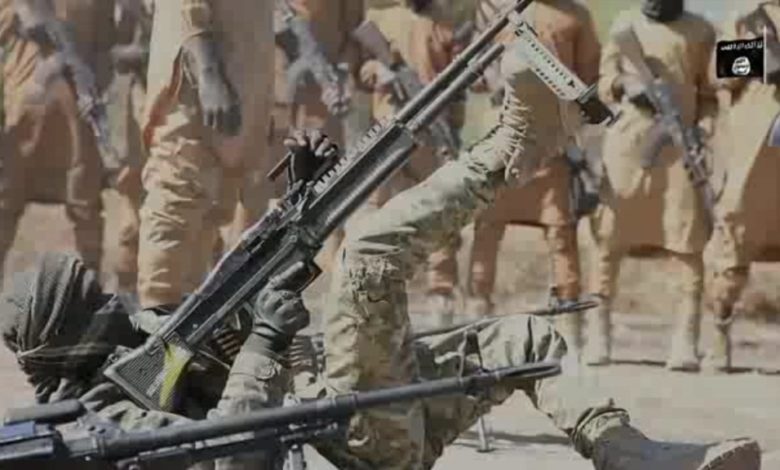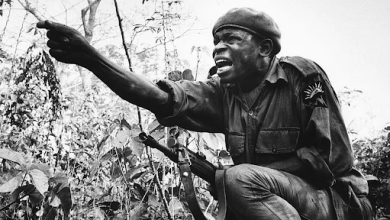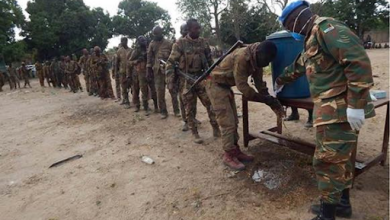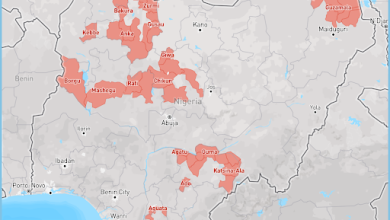Insurgents In Northeast Nigeria, Lake Chad Reusing Seized Military Weapons

Propaganda videos released by the Jamā’at Ahl as-Sunnah lid-Da’way Wa’l-Jihād (JAS) between December and January provided a glimpse into how terror groups in Northeast Nigeria and Lake Chad Basin reuse captured military arms to cause havoc.
It has been over a decade since the group, also known as Boko Haram, launched an uprising and subsequently a bloody insurgency campaign against Nigeria and neighbouring Lake Chad Basin countries.
A major area of debate and interest has been the source of weapons and gun trucks used by Boko Haram and its splinter faction Islamic State West Africa Province (ISWAP).
HumAngle’s analysis of military recoveries and media materials from the terror groups revealed that the arms and ammunition include those captured during raids and ambushes targeting national armies and security personnel of the four Lake Chad Basin countries of Nigeria, Chad, Niger and Cameroon.

In the recent Boko Haram videos, fighters are seen mimicking military combat drills and holding different variants of the Kalashnikov assault rifle with underfolding, side-folding and fixed wooden stocks.
The Kalashnikov assault rifle is widely used among state and non-state actors including rebel and Jihadist groups in the Sahel.
A distinctive feature in the videos was the presence of Zastava M21 rifles most likely captured from Cameroonian security forces, a rare M-60 machine gun with Nigerian Army marking and Dragunov sniper rifle common with Nigerien military snipers.

On Jan. 22, Nigeria’s military published a picture showing a worn-out variant of the AKM with a folding butt and a Polish Beryl M762 rifle recovered by troops during an encounter with ISWAP fighters in Damboa, Borno, a state in Northeast Nigeria.
The Polish Beryl M762 assault rifle was introduced into Nigerian Army service in 2015 and was a distinct primary weapon used by the 72 Mobile Strike Force, a subunit of the 72 Special Forces Battalion.

The reuse of captured gun trucks, usually Toyota Hilux and Landcruiser Buffalo trucks with camouflage painting and often heavy machine guns, has similarly been a disturbing trend.
Counteroffensive operations by the Nigerian military in the Northeast between Jan. 1 and 17 resulted in the destruction and capturing of over 20 ISWAP gun trucks.

In a two-part article on ISWAP weaponry, arms researcher Calibre Obscura observed the use of AK-74 rifles customised with unique attachments from Zenitco, a firearms accessory company in Russia. Another rare firearm spotted was the Armalite AR-10 A-Series SuperSASSS long-range rifle system.
The Armed Forces Special Forces (AFSF), an elite group of operators drawn from different armed services and trained in Belarus, are known to use AK-74 rifles with Zenitco tactical accessories.
Meanwhile, the AR-10-based 7.62mm sniper rifle appears to have been part of weapons purchased to support the military offensive in 2015 against Boko Haram.
Other weapons observed were the FN machine gun, Zastava M21, DShK heavy machine gun, RPG rounds, ZPU-2 anti-aircraft gun and OTO Melara Mod 56 howitzer.
HumAngle understands that insurgents are shifting away from their original approach of capturing heavy military weapon systems due to vulnerability to airstrikes. They now tend to quickly set such equipment ablaze, loot ammunition and in some cases break down armour parts to make bomb-laden vehicles later employed against troops.
This shift was highlighted in incidents related to the appearance of Otokar Cobra and Mowag Piranhas armoured vehicle parts in vehicle-borne improvised explosive devices.
In April 2020, ISWAP shared a picture of a camouflage painted pickup truck fitted with four Grad 122mm unguided rocket launcher tubes mounted at the rear of the vehicle reportedly used to target Buni Yadi, a town in Yobe State.

The first known use of Grad rockets was on the morning of Feb. 23, 2019, when ISWAP targeted Maiduguri hours before voting began for presidential and parliamentary elections.
The group has also used the Grad rocket to target other towns including Diffa in Niger Republic, Doksa and recently Goniri in Borno.
The 122mm Grad rockets are usually mounted on a Russian made BM-21 and its heavier Czech variant, the RM-70 multiple launch rocket systems (MLRS) trucks, which are in the stock of the Nigerian Army.
The rockets were looted during attacks on Nigerian military bases in Metele and Baga in 2018.
The Air Force was able to destroy the BM-21 captured in Baga in Dec. 2018, a move that indicates the improvement of Nigerian Air Force airborne surveillance and air strike capability, which has played a significant role in discouraging insurgents from moving and reusing such heavy military weapon systems.
The ongoing insurgency has killed at least 30,000 people, displaced over two million people from homes and left more than 7.1 million people relying on humanitarian assistance to survive. And experts on jihadi conflict believe an important component of ending the prolonged war involves protecting military equipment from falling into the hands of terror groups.
Support Our Journalism
There are millions of ordinary people affected by conflict in Africa whose stories are missing in the mainstream media. HumAngle is determined to tell those challenging and under-reported stories, hoping that the people impacted by these conflicts will find the safety and security they deserve.
To ensure that we continue to provide public service coverage, we have a small favour to ask you. We want you to be part of our journalistic endeavour by contributing a token to us.
Your donation will further promote a robust, free, and independent media.
Donate HereStay Closer To The Stories That Matter




